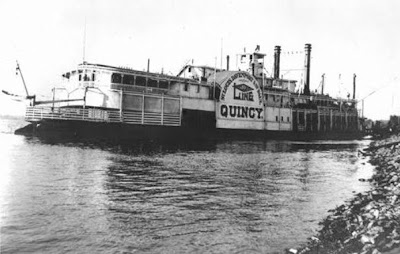
Timeline of Quincy Founder John Wood...
• Born December 20, 1798, in Moravia, Cayuga County, New York
• Father was Daniel Wood, Mother was Katherine Krause Wood
• John’s father was a surgeon in the Revolutionary War and could speak several foreign languages fluently and was assigned to George Washington’s headquarters
• One sister named Clarissa
• Headed west November 2, 1818
• Located in Pike Co. IL to farm in 1820
• Purchased 160 acres in Military Tract for $60 from a Mr. Flinn • Came to this area with Willard Keyes and built log cabin in 1822 at foot of Delaware Street
• Married Anna M. Streeter in Quincy, on January 25, 1826
• Eight children: Ann (1827-1905), Daniel (1829-1922), John Jr. (1830-1889), Emily (1833-1835), Adah (1835-1844), Joshua (1837-1910), Henry (1839-1842), James (1842-1850)
• Wood and wife went to Galena, IL during rush to lead mines in 1827• Built Greek Revival home at 12th & State (1835-1838)
• Volunteered for Black Hawk War in 1832 • Mayor of Quincy 1844-1848, 1852-53 and 1856
• Gave land for Woodland Cemetery in 1846 • Wood and sons Daniel & John Jr. went to California in 1849 for gold
• Elected to Illinois State Senate in 1850
• Elected Illinois Lieutenant Governor in 1857
• Started constructing Octagonal House in 1857
• Became Illinois' 12th Governor when William Harrison Bissell died in 1860, Wood finished term
• Governor Richard Yates appointed Wood a delegate from Illinois to Peace Congress to avert secession of Southern states in Feb., 1861
• Served as Quartermaster for IL during Civil War
• Wife Ann died in 1863
• Married Mary Ann Brown Holmes, widow of Rev. Joseph Holmes in 1865
• Octagonal House cost $200,000 to build
• Gave Greek Revival house to son Daniel
• Had to sell Octagonal House because financial reverses due to recession and failed businesses in 1876, moved back to Greek Revival home with son
• Died in Greek Revival home on June 4, 1880 and buried in Woodland Cemetery





 If you have any old photographs that you would like to share on this blog, please send them in, and I'll post them. Any old or interesting photos from Quincy, Adams County, or anything that relates to the history in said area. Old maps, and similar items are welcome. Please email them to me, but please supply the related information. By that I mean the who/what/when/where. At least the when/where. The more old pics, the more interesting your next visit to the blog will be!
If you have any old photographs that you would like to share on this blog, please send them in, and I'll post them. Any old or interesting photos from Quincy, Adams County, or anything that relates to the history in said area. Old maps, and similar items are welcome. Please email them to me, but please supply the related information. By that I mean the who/what/when/where. At least the when/where. The more old pics, the more interesting your next visit to the blog will be!


























